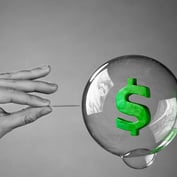2015 was a year of “intense frustration,” David Kelly, chief global strategist for JPMorgan Asset Management, said on a call on Tuesday. Oil was too low and the dollar was too high; China and Europe caused investors concern, as well as a potential government shutdown in the United States, not to mention uncertainty over when the Fed would raise interest rates.
“It was just confusing for a lot of people. I think all that confusion caused people to hesitate to invest,” Kelly said, which led to a “miserable year” for total returns.
Kelly said there was almost $12 trillion in savings accounts, including CDs and IRAs, and money market funds last year. That’s about $37,000 for “every man, woman and child in America,” he said. The money sitting in cash is not good for the economy, for clients or for advisors, he said. “The real question is how can we give investors the courage to invest properly and the understanding to invest properly this year?”
Kelly said investors this year need to understand what’s going on with energy, China, the dollar, the Fed, and then “take a look at valuations. The cardinal rule of investing is make sure you look at valuations,” he said.
Oil ‘All About Supply’
Kelly acknowledged that he didn’t think oil would be lower at the end of 2015 than it was at the beginning. The problems in that sector are with supply, not demand, he noted. Between 1996 and 2013, the average annual growth rate of global oil consumption was 1.4% per year. Projections from 2013 to 2016 come out to the same rate, he said.
“There hasn’t really been any change in consumption,” he said. The problem is a surge in oil inventory, and problems at OPEC.
Kelly said that when prices were falling during the November 2014 meeting of OPEC, the organization declined to cut production. “What was going on at the time is that OPEC was falling apart,” he said. “There’s a blood feud between the Sunni and the Shiite, between Saudi Arabia and Iran.”
He compared the situation to the movie “War of the Roses,” where the protagonists would rather suffer themselves than let the other go unscathed. He said Saudi Arabia and Iran will “beat the tar out of each other in a proxy way.”
He expects production will continue to fall, “quite significantly,” he said, while consumers increase consumption. “People are basically wasting energy because it’s cheap,” Kelly said.
He said it’s difficult to predict the price of oil (although he did say he expects it to be between $45 and $50 a barrel), even with surplus OPEC production, the increase in consumer demand will eventually “mop up inventory surplus and push prices up a bit.”
China
China’s economy is slowing, but it’s hard to tell how much as “the Chinese economic numbers are fake,” Kelly said. The renminbi is too high to support exports, the housing market is overbuilt and there’s a long-term debt problem the country will have to face.
“They’ve got a lot of problems,” Kelly said of China.
Add to that the “spectacle of global markets freaking out” last August due to volatility in China. He called Monday’s market drop an “aftershock” of that.
The good news is that these problems can be managed, he said. The People’s Bank of China can adjust the exchange rate any way it wants, Kelly said. Furthermore, the Chinese government can stabilize the stock market.
“They have a will and a way. In the U.S., there’s not much will and there’s not much way. The government doesn’t have really any authority or will or desire to manage the stock market on a day-to-day or hour-to-hour basis.”
Even if the U.S. government wanted to do so, total stock market capitalization in the U.S. is about 100% of GDP, compared with 13% in China.
Corporate Profits
The big problems for corporate profits last year were the growth of the dollar and the drop in energy prices, Kelly said.
The dollar was up about 16% year-over-year in 2015, Kelly said, which took about 6% out of S&P 500 profits. In 2011, the energy sector was responsible for about 11% of S&P 500 earnings, while in 2015, it accounted for -1%.








 January 06, 2016 at 07:51 AM
January 06, 2016 at 07:51 AM










